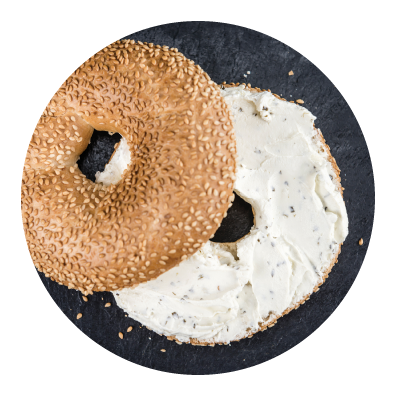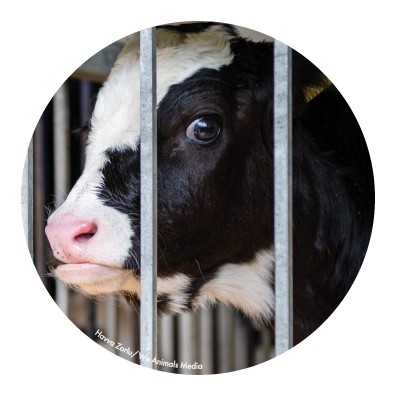Dairy is udderly suspect
Take Action
Virtually all kosher chickens, cattle, and fish suffer the worst abuses of factory farming, and everyone pays the price. Help your community transition to more humane and sustainable food practices with new resources, consultation, and training.
Jewish tradition has long regarded dairy as intrinsic to the definition of kosher law.
Dairy is symbolic of ethnogeographic roots (“a land flowing with milk and honey”) and connected to ritual on holidays such as Shavu’ot and Hanukkah. While the dairy source of our shepherd ancestors came primarily from small-scale herds of goats and sheep, most Jews now consume the most widely available commercial products from industrial dairies.
Like other farmed species, today most dairy cows do not become pregnant through natural mating; they’re forcibly impregnated through artificial insemination. After they give birth, they produce more milk than ever before due to intensive artificial selection enabled by DNA sequencing. Per capita milk production has doubled in the past forty years and continues to climb. If a dairy cow was producing just enough to feed her calf, she would only produce about one gallon of milk per day. Instead, the average American dairy cow now produces over 24,000 pounds of milk every year and averages more than 7.5 gallons of milk per day.
This unnaturally high milk load has created the dairy industry’s two biggest welfare issues, decade after decade: mastitis and lameness. These painful conditions are exacerbated by the living conditions inside factory farms where most American dairy cows live. Contrary to the happy pastoral scenes used in dairy advertising, over 90 percent of cows live almost exclusively inside barns on concrete floors slick with sewage, where their joints and hooves bear the weight of a full udder most of their adult lives. Mastitis is an udder infection, and factory farms’ high-humidity, low-ventilation environment promotes bacterial growth. Cows live in tie-stalls where they are tethered by the neck except when they are milked. This confinement severely limits opportunities for natural behaviors like exploring, socializing, and grooming. Industrial dairies are an animal welfare nightmare.
Convenience comes at a cost, both to cows and to the planet. Whether raised for meat or dairy, cows are leading greenhouse gas emitters. The processes required to raise them (e.g., alfalfa production for their feed) are very carbon-intensive, and the animals themselves generate methane and nitrous oxide in massive quantities. Milk’s water footprint hovers around 50 gallons for every cup, contributing heavily to droughts and dry-ups in the American West. Consider also that many gallons of milk are required to produce a finished dairy product such as cheese. Cheese consistently ranks as one of the worst foods for the climate, generating more GHGs than fish, poultry, or eggs.
In keeping up with our appetite for ice cream and asiago, dairy production shows no signs of slowing down. Just four months after giving birth, dairy cows are reimpregnated and will go through 4-5 pregnancies before being slaughtered, usually for ground beef around age four, though their lifespans would normally reach twenty years. Male calves are also sent to slaughter, as are about a quarter of female calves and any cows who exhibit infertility or whose milk production has declined. Given the stress, disease, and generally poor body condition of the average dairy cow, it’s little wonder that one in ten cows struggles to conceive. Those who do conceive don’t wean their young naturally because standard industry practice separates calves from their mothers within 24 hours of birth. Calves naturally wean at an average age of about eight months. Female calves become replacements, growing up to become the next generation of milk-producers.
From caring for animals’ well-being to protecting the Earth’s ecological balance, water resources, and climate, there are many Jewish values-based reasons to commit to alternatives to industrial dairy.

